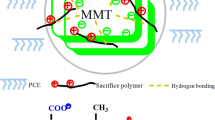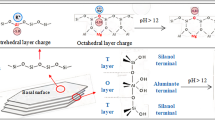Abstract
The dispersion ability of polycarboxylate superplasticizer (PCE) in fresh concrete was much impeded by clay impurities. To improve the dispersion of PCE in the clay-contained concrete, a novel PCE with carboxyl as a specific branched chain terminal group was synthesized, using modified polyether as the raw material which was prepared through esterification between hexahydrophthalic anhydride (HHPA) and isobutenyl polyoxyethylene ether (IPEG) with hydroxy as the terminal group. The esterification product and PCE molecular structure were characterized by infrared spectroscopy and 1HNMR resonance. The results confirmed that the product molecular structure was a comb-type copolymer with long-chain terminal carboxyl group and PEO attached directly to the backbone chain. The as-synthesized PCEs had favorable dispersibility in cement than conventional PCE in the presence of montmorillonite (Mmt) clay. This can be attributed to the introduction of electronegative carboxyl to PCE long-chain terminal group, which reduces the adsorption of PCE on Mmt, and thus improves the tolerance of PCE to the Mmt.
Similar content being viewed by others
References
Yoshioka K, Sakai E, Daimon M, et al. A Role of Steric Hindrance in the Performance of Superplasticizers for Concrete[J]. J. Am. Ceram. Soc., 1997, 80: 2667–2671
Yamada K, Takahashi T, Hanehara S, et al. Effects of the Chemical Structure on the Properties of Polycarboxylate-type Superplasticizer[J]. Cem. Concr. Res., 2000, 30: 197–207
Winnefeld F, Becker S, Pakusch J, et al. Effects of the Molecular Architecture of Comb-shaped Superplasticizers on Their Performance in Cementitious Systerms[J]. Cem. Concr. Compos., 2007, 29: 251–262
Ahmad Habbaba A L J P. Synthesis and Performance of a Modified Polycarboxylate Dispersant for Concrete Possessing Enhanced Cement Compatibility[J]. J. Appl. Polym. Sci., 2013, 129: 346–353
Alonso M, Palados M, Puertas F. Effect of Polycarboxylate Admixture Structure on Cement Paste Rheology[J]. Materiales De Construccion., 2007, 57 (286): 65–81
Singh N B, Middendorf B, Gajbhiye N S. Hydration of Ternary Blended Cement in the Presence of PC Type Superplasticizer[J]. ZKG Int., 2012, 65 (1): 54–63
Liu J, Ran Q, Miao C. Effects of Grafting Densities of Comb-like Copolymer on the Dispersion Properties of Concentrated Cement Suspensions[J]. Mater. Trans., 2012, 53 (3): 553–558
Kong F R, Pan L S, Wang C M, et al. Effects of Polycarboxylate Superplasticizers with Different Molecular Structure on the Hydration Behavior of Cement Paste[J]. Construction and Building Materials, 2016, 105: 545–553
F Dalas, A Nonat, S Pourchet, et al. Tailoring the Anionic Function and the Side Chains of Comb-like Superplasticizers to Improve Their Adsorption[J]. Cem. Concr. Res., 2015, 67: 21–30
Atarashi D, Sakai E, Obinata R, et al. Interactions between Superplasticizers and Clay Minerals[J]. Cem. Sci. Concr. Technol., 2004, 58: 387–392
Norvell J K, Stewart J G, Juenger M C, et al. Influence of Clays and Clay-Sized Particles on Concrete Performance[J]. Journal of Materials in Civil Engineering, 2007, 19(12): 1053–1059
Fernandes V A, Purnell P, Still G T, et al. The Effect of Clay Content in Sands Used for Cementitious Materials in Developing Countries[J]. Cement and Concrete Research, 2007, 37(5): 751–758
Ng S, Plank J. Interaction Mechanisms between Na Mmt Clay and MPEG-based Polycarboxylate Superplasticizers[J]. Cement and Concrete Research., 2012, 42(6): 847–854
Lei L, Plank J. A Study on the Impact of Different Clay Minerals on the Dispersing Force of Conventional and Modified Vinyl Ether Based Polycarboxylate Superplasticizers[J]. Cement and Concrete Research, 2014, 60: 1–10
Lei L, Plank J. A Concept for a Polycarboxylate Superplasticizer Possessing Enhanced Clay Tolerance[J]. Cement and Concrete Research, 2012, 42(10): 1299–1306
Lei L, Plank J. Synthesis and Properties of a Vinyl Ether-based Polycarboxylate Superplasticizer for Concrete Possessing Clay Tolerance[J]. Ind. Eng. Chem. Res., 2014, 53 (3): 1048–1055
Li Yinwen, Zheng Xiuwen, Wu Kun, et al. Synthesis of Amphiphilic Polycarboxylate Copolymer and Its Notable Dispersion and Adsorption Characteristics onto Cement and Clay[J]. Advances in Cement Research, 2016, 28(5): 344–353
Guobing X. Grafting Tertiary Amine Groups into the Molecular Structures of Polycarboxylate Superplasticizers Lowers their Clay Sensitivity[J]. RSC Advances, 2016, 6: 106921–106927
Xu H, Sun S, Wei J, et al. β-Cyclodextrin as Pendant Groups of a Polycarboxylate Superplasticizer for Enhancing Clay Tolerance[J]. Industrial & Engineering Chemistry Research, 2015, 54(37): 9081–9088
B K G Theng. Clay-polymer Interactions: Summary and Perspectives[J]. Clays and Clay Minerals., 1982, 30(1): 1–10
M J Sanchez-Martin. Influence of Clay Mineral Structure and Surfactant Nature on the Adsorption Capacity of Surfactants by Clays[J]. Journal of Hazardous Materials., 2008, 150: 115–123
Johann Plank. A Microstructural Analysis of Isoprenol Ether-based Polycarboxylates and the Impact of Structural Motifs on the Dispersing Effectiveness[J]. Cement and Concrete Research, 2016, 84: 20–29
Etelka Tombácz, Márta Szekeres. Colloidal Behavior of Aqueous Mmt Suspensions: the Specific Role of pH in the Presence of Indifferent Electrolytes[J]. Applied Clay Science., 2004, 27: 75–94
Tsuyoshi Hirata, Paulo Branicio, Jun Ye, et al. Atomistic Dynamics Simulationto Solve Conformation of Model PCE Superplasticisers in Water and Cement Pore Solution[J]. Advances in Cement Research., 2017: 1–11
Plank J, Pöllmann K, Zouaoui N, et al. Synthesis and Performance of Methacrylic Ester Based Polycarboxylate Superplasticizers Possessing Hydroxy Terminated Poly(ethylene glycol) Side Chains[J]. Cement and Concrete Research, 2008, 38(10): 1210–1216
Author information
Authors and Affiliations
Corresponding author
Rights and permissions
About this article
Cite this article
Chen, G., Lei, J., Du, Y. et al. Synthesis of a novel polycarboxylate superplasticizer with carboxyl group as side chain terminal group to enhance its clay tolerance. J. Wuhan Univ. Technol.-Mat. Sci. Edit. 33, 226–232 (2018). https://doi.org/10.1007/s11595-018-1810-3
Received:
Accepted:
Published:
Issue Date:
DOI: https://doi.org/10.1007/s11595-018-1810-3




